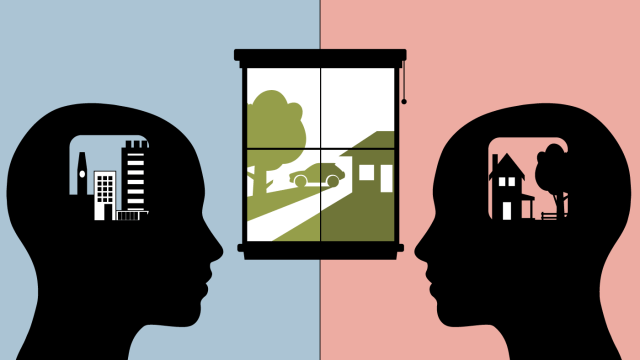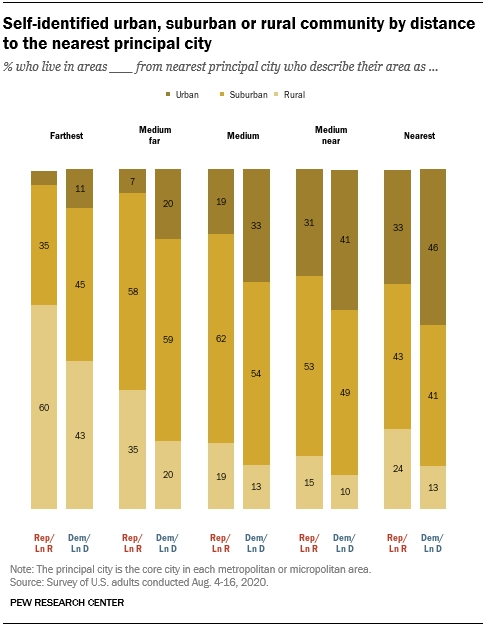
(Related posts: Evaluating what makes a U.S. community urban, suburban or rural and Measuring community type in Europe, from big cities to country villages)
Partisanship in the United States has become increasingly associated with geography. Over the past two decades, people living in urban areas have become more likely to identify as Democrats or lean toward the Democratic Party, while larger shares of those living in rural areas identify as Republicans or lean toward the GOP. Democrats and Republicans also express strikingly different preferences for the kinds of communities they would like to live in.
But the partisan differences don’t end there. Even when they live in similar areas, Democrats are more likely than Republicans to describe their community as urban, while Republicans are more likely than Democrats to describe it as rural, according to a Pew Research Center analysis of a nationally representative sample of 13,200 U.S. adults. In this post, I’ll describe how we arrived at that conclusion and what it may mean for future research projects.
Background
It’s difficult to objectively classify communities as urban, suburban or rural. But our research has found that self-reported descriptions of community type line up well with several outside categorizations used by government agencies.
The starting point for our new analysis was a 2018 Pew Research Center survey, which asked respondents directly to describe their communities as urban, suburban or rural. Democrats and Republicans responded slightly differently to this question, even when they lived in the same types of places, as determined by a range of outside indicators of urbanity. These indicators included population density, distance from the nearest major city and the luminosity of a particular ZIP code — that is, the amount of light picked up in nighttime satellite images.
Across all of these measures, Democrats were consistently more likely than Republicans to use the denser descriptor (e.g., urban or suburban rather than rural), while Republicans were more likely to use the more sparse descriptor (e.g., suburban or rural rather than urban).
Comparisons with outside measures
Let’s look more closely at how survey respondents’ descriptions of their communities differed by the three outside measures of urbanity mentioned above.

To measure population density, we used estimates from the U.S. Census Bureau’s Census Planning Database and classified the census block group where each respondent lives into five groups based on the quintiles of population density in the data: low, medium low, medium, medium high or high density.
Across all five quintiles, Democrats were more likely than Republicans to describe their community as urban. Meanwhile, within all quintiles except high density, Republicans were more likely than Democrats to describe their community as rural. (Very few respondents in high-density areas described their community as rural.)
When it comes to the likelihood that Democrats and Republicans would describe their community as suburban, again we see that Democrats are more likely to use the denser descriptor compared with Republicans living in similar areas. Democrats in the least densely populated places were more likely than Republicans in those areas to describe their areas as suburban, and less likely to describe them as rural. Meanwhile, Democrats in the highest-density places were less likely than Republicans living in those same areas to describe their areas as suburban, and more likely to describe them as urban.
These differences were not overwhelming, but there did appear to be consistent differences in the ways Democrats and Republicans described their communities.

A similar pattern emerged when we looked at how far respondents live from the nearest major city, defined here as the distance from the respondent to the population-weighted mean location of the nearest “principal city” — the core city in each metropolitan or micropolitan area. Again, we divided respondents into five categories defined as the quintiles of all respondents in terms of distance to such a city.
Considering two people who live the same distance from a major city, Democrats were again more likely than Republicans to describe their community as urban. And Republicans were again more likely than Democrats to describe it as rural.

The same pattern appeared when looking at luminosity — a metric that is increasingly being used as a kind of proxy for community type. To measure luminosity, we relied on data collected by the Payne Institute.
Among people living in areas with the most light emitted in nighttime satellite imagery, Democrats were more likely than Republicans to describe their communities as urban. Among those living in areas with the least amount of light, Republicans were more likely than Democrats to describe their communities as rural. As above, respondents were grouped based on the quintiles in the luminosity data.
Using multiple regression to bring it all together
It’s possible that the patterns we observed were picking up other differences in the ways in which Democrats and Republicans are distributed around the country. For example, it may be that Republicans are more likely to live in and around cities that have a different character from those Democrats tend to live near. The data seems to bear this out to some degree.

Multiple regression allows us to control for many different observable factors simultaneously. When we include these factors in a regression analysis designed to help us understand the relationship between our outside measures of community type and the descriptions provided by our survey respondents, we can see that partisanship remains an important factor.

The accompanying graphics show the absolute values of the regression coefficients so that we can compare their magnitudes. With the exception of partisanship, all of the variables have been standardized (by subtracting the sample mean and dividing by the sample standard deviation) to facilitate comparison.
To be sure, the effect is smaller than many of the outside factors we considered. For instance, majorities of those living in high-density areas describe their area as urban, regardless of partisanship. But even after controlling for the sizable impact of urban density on how Americans self-identify, there is a partisan difference.
Community type as an identity
Classifications for whether a given area is urban, suburban or rural are inherently subjective, which is one of the main reasons we have typically relied on self-reported information at Pew Research Center. It’s extraordinarily difficult to apply a single rule to the entire country based on any “objective” factor. (Believe me, I’ve tried.)
The self-reported measure is not without its own complications. As the analysis here shows, individuals seem to bring other considerations to bear when deciding whether or not their community is urban, suburban or rural. The impact of partisanship is not overwhelming, but when there is ambiguity, it seems to be enough to push some people over the line between classifying their community in one way rather than another.





